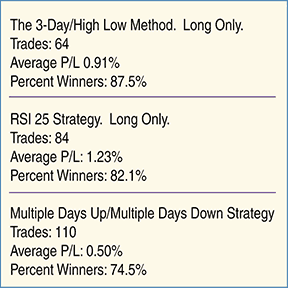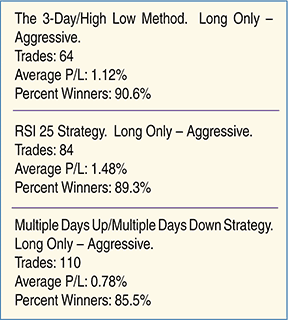TRADING STRATEGIES
Be Aggressive
Advanced Scale-In Strategies For Short-Term Traders
How can short-term traders add an edge of as much as 10% to their per-trade win rate?
High-probability exchange traded fund (Etf) trading is a quantified strategy of buying Etfs after they have pulled back and selling after they have recovered in price. More than 100 Etfs were tested since inception. The results of the testing showed that buying Etfs after they had pulled back and become oversold resulted in high-probability Etf trading strategies that were correct more than 75% of the time.
These tests included all of the most widely traded Etfs from the Standard & Poor’s 500 Spdrs Etf (Spy) to country Etfs like the iShares Ftse/Xinhua China 25 Etf (Fxi) to sector Etfs like the Financial Select Sector Spdrs Etf (Xlf) since inception. In the case of Spy, this meant including data going back to 1993.
Figure 1 consists of the performance results for the Spy since inception through December 31, 2008, in three of the seven high-probability Etf trading strategies that are part of the seven trading strategies recently published in Larry Connors’ book, High Probability Etf Trading (see sidebar “Etf Trading Strategies”). These results with the Spy were consistent with those from the other Etfs tested. I use the Spy here for simplicity’s sake and because the Spy has the most extensive data from which to draw.

FIGURE 1: PERFORMANCE RESULTS FOR SPY SINCE INCEPTION THROUGH DECEMBER 31, 2008
Figure 2 involves the exact same strategies, but with a twist. That twist is an edge: scaling in.

FIGURE 2: performance results using scaling-in strategies
The scale-in solution
The only difference between the strategies in Figure 1 and their counterparts in Figure 2 is that the strategies in Figure 2 all used “aggressive” variations on the basic high-probability Etf strategy. That variation called for scaling-in with a second unit (a second unit long in these instances of long trades) if the market moved lower after the initial position was taken.